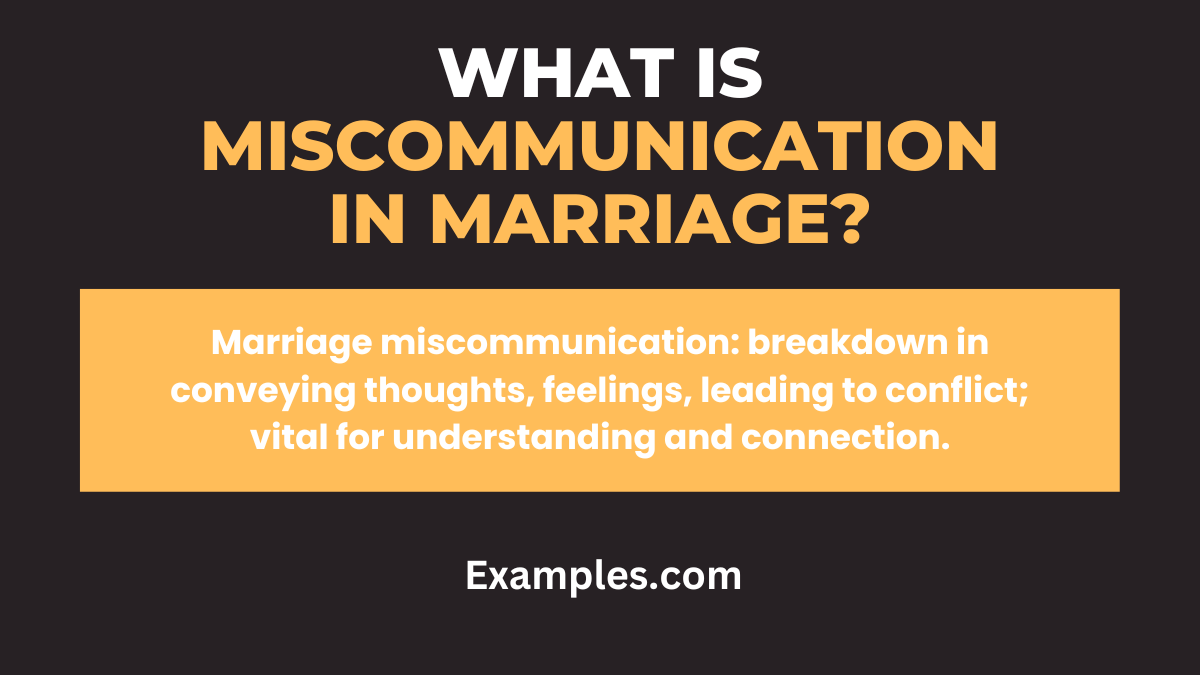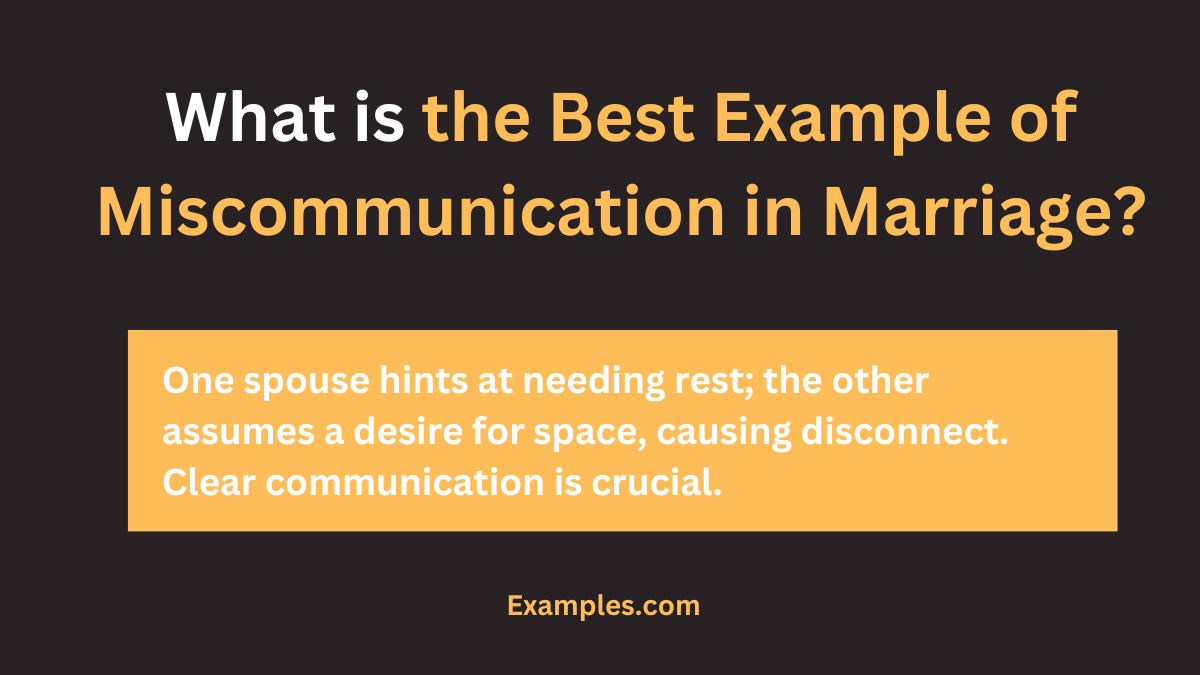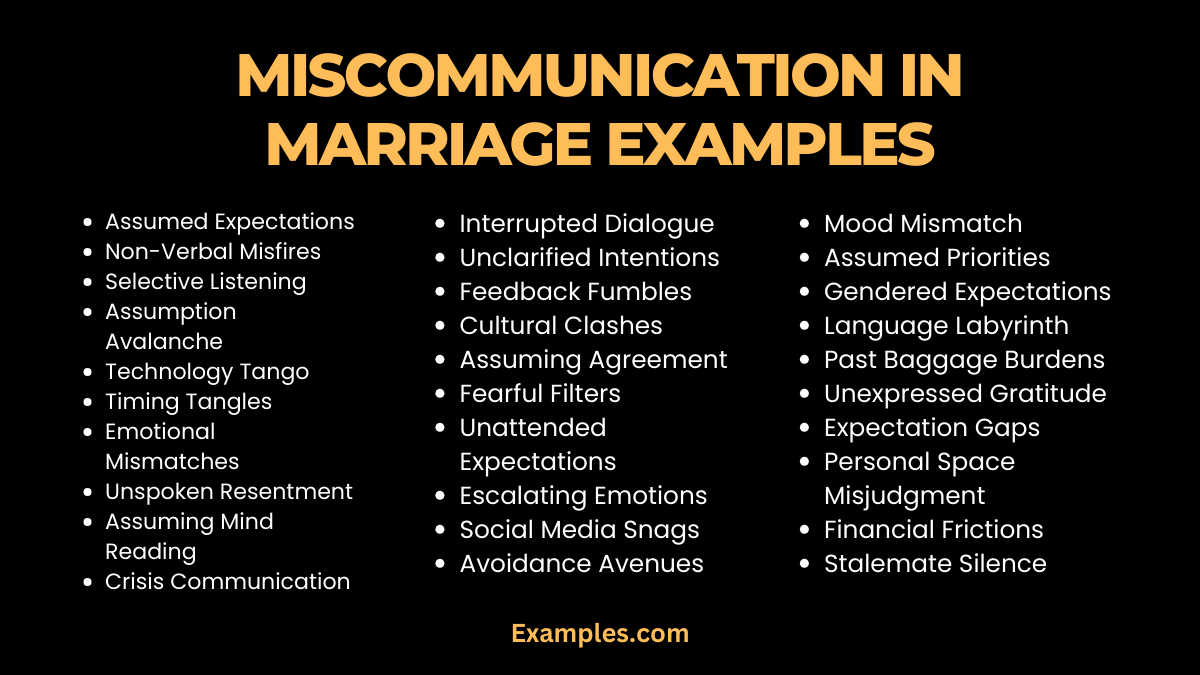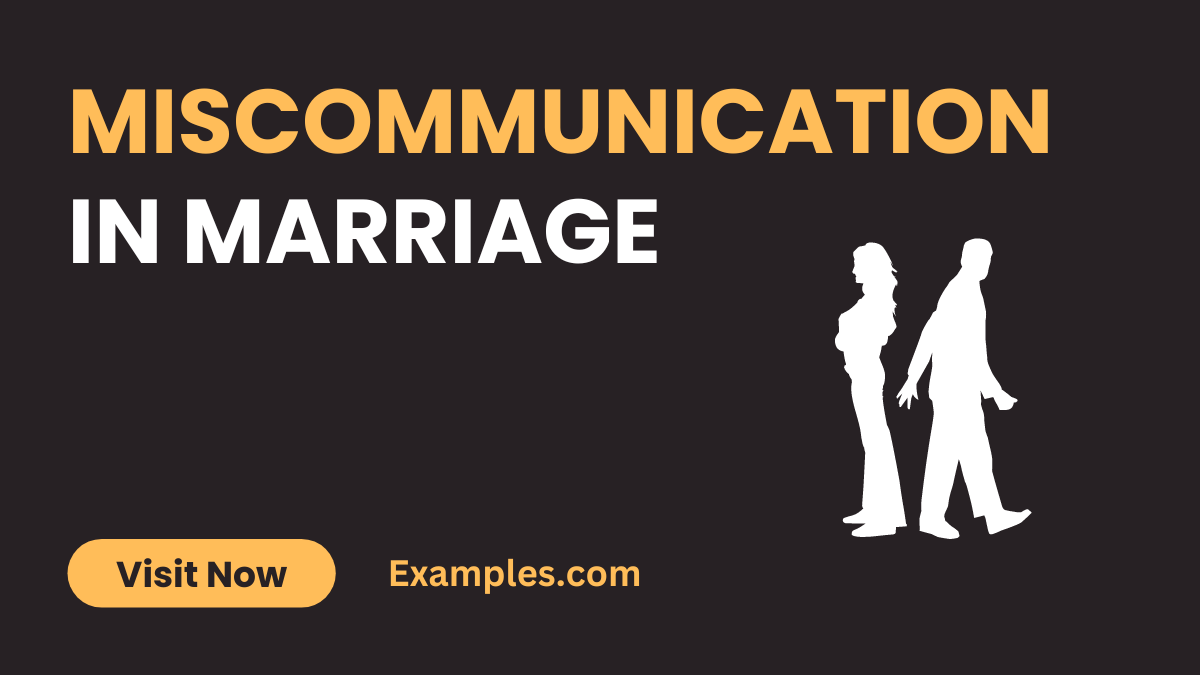Miscommunication in Marriage
Navigating miscommunication in marriage is crucial for a thriving relationship. In this comprehensive guide, we delve into effective strategies to address and resolve misunderstandings, promoting a deeper connection between partners. Discover insightful communication examples that illuminate common pitfalls and offer practical solutions. Learn to foster understanding, empathy, and open dialogue, empowering couples to build a resilient and harmonious bond. Strengthen your marriage by mastering the art of communication, ensuring a foundation of trust and mutual support.
What is Miscommunication in Marriage?

Miscommunication in marriage refers to the breakdown or failure in conveying thoughts, feelings, or intentions between spouses. It occurs when messages are misunderstood, leading to confusion, frustration, or conflict. This phenomenon encompasses verbal and non-verbal exchanges, including gestures and expressions. Miscommunication can stem from differing communication styles, unspoken expectations, or emotional nuances. Recognizing and addressing these breakdowns is essential for fostering a healthy marital relationship, emphasizing the importance of effective communication for sustained understanding and connection between partners.
What is the Best Example of Miscommunication in Marriage?

Consider a scenario where one spouse, eager for a quiet evening at home, drops subtle hints about feeling tired and needing rest. However, the other spouse interprets these cues as a desire for space and assumes there’s no interest in spending time together. As a result, the evening unfolds with one partner feeling neglected and the other feeling misunderstood. This miscommunication exemplifies how unspoken expectations and misinterpretations can lead to disconnect in marriage, emphasizing the need for open, clear communication to avoid such pitfalls.
30 Miscommunication in Marriage Examples

- Assumed Expectations: Assuming your partner understands without explicit communication can lead to confusion. Address by openly sharing expectations.
- Non-Verbal Misfires: Misinterpreting gestures and expressions often stems from unspoken emotions. Clarify feelings to avoid these non-verbal communication breakdowns.
- Selective Listening: Failing to fully grasp your partner’s message can result in misunderstandings. Practice active listening, ensuring both perspectives are acknowledged and understood.
- Assumption Avalanche: Building assumptions upon assumptions can create a snowball effect of miscommunication. Break the chain by validating information through open dialogue.
- Technology Tango: Relying solely on digital communication may lead to misinterpretations. Balance virtual and face-to-face interactions to ensure a holistic understanding.
- Timing Tangles: Discussing important matters at the wrong time can hinder effective communication. Choose appropriate moments to address concerns for better reception.
- Emotional Mismatches: Differing emotional states can lead to misreading signals. Foster emotional intelligence to navigate these mismatches and connect more deeply.
- Unspoken Resentment: Unresolved issues can breed resentment, impacting communication. Tackle concerns promptly, promoting a healthier, resentment-free relationship.
- Assuming Mind Reading: Expecting your partner to read your mind invites miscommunication. Clearly express your thoughts, fostering a culture of open communication.
- Crisis Communication: During crises, miscommunication can escalate tension. Establish a crisis communication plan to navigate challenges together seamlessly.
- Interrupted Dialogue: Constant interruptions hinder meaningful conversations. Set aside dedicated time for uninterrupted discussions, fostering a more conducive communication environment.
- Unclarified Intentions: Unclear motives can lead to misinterpretations. Clearly articulate your intentions to avoid confusion and promote transparency.
- Feedback Fumbles: Constructive feedback can be misinterpreted as criticism. Frame feedback positively, emphasizing growth and improvement rather than blame.
- Cultural Clashes: Cultural differences may lead to misunderstandings. Embrace diversity, discuss cultural nuances, and cultivate mutual respect to bridge communication gaps.
- Assuming Agreement: Assuming agreement without explicit confirmation can lead to unmet expectations. Regularly check in with your partner to ensure you are on the same page.
- Fearful Filters: Fear-driven communication filters can distort messages. Foster a safe space where both partners feel comfortable expressing their thoughts without judgment.
- Unattended Expectations: Uncommunicated expectations can result in unmet needs. Clearly communicate desires and expectations to avoid disappointments.
- Escalating Emotions: Allowing emotions to escalate can hinder effective communication. Practice emotional regulation techniques to maintain a calm and productive dialogue.
- Social Media Snags: Miscommunication can arise from misinterpreted social media posts. Clarify intentions and discuss potential concerns arising from online interactions.
- Avoidance Avenues: Avoiding difficult conversations may lead to misunderstandings. Encourage open dialogue, tackling issues head-on to strengthen the foundation of trust.
- Mood Mismatch: Divergent moods between partners can lead to misread signals. Acknowledge and discuss mood differences to foster empathy and understanding.
- Assumed Priorities: Assuming shared priorities can result in conflicting expectations. Regularly revisit and communicate individual and shared goals to align perspectives.
- Gendered Expectations: Traditional gender roles may impact communication dynamics. Challenge stereotypes, openly discussing and redistributing responsibilities for a more equitable partnership.
- Language Labyrinth: Varied interpretations of language nuances can lead to confusion. Clarify meanings and avoid assumptions to ensure shared understanding.
- Past Baggage Burdens: Unresolved past issues may influence present communication. Address lingering concerns, seeking closure to prevent past conflicts from resurfacing.
- Unexpressed Gratitude: Failing to express gratitude can be misunderstood as indifference. Cultivate a culture of appreciation by vocalizing gratitude for your partner’s efforts.
- Expectation Gaps: Discrepancies in expectations about roles and responsibilities can lead to frustration. Regularly reassess and communicate expectations to maintain balance.
- Personal Space Misjudgment: Misinterpreting the need for personal space can strain relationships. Establish boundaries and communicate the importance of occasional solitude.
- Financial Frictions: Discrepant financial goals and spending habits may lead to miscommunication. Establish clear financial plans and priorities through open discussions.
- Stalemate Silence: Prolonged silent treatment during conflicts can hinder resolution. Break the silence by initiating a calm and constructive conversation to address underlying issues.
Understanding these examples sheds light on the multifaceted nature of miscommunication in marriage. By proactively addressing these scenarios with open communication and empathy, couples can build a stronger foundation for a lasting and fulfilling relationship.
How do you Fix Miscommunication in a Marriage?
1. Navigating Miscommunication in Marriage: Strategies for Resolution
Miscommunication in marriage is common, but understanding how to fix it is pivotal for a thriving relationship. Explore actionable strategies, such as active listening, fostering empathy, and promoting transparent dialogue. Learn to pinpoint the root causes of miscommunication and implement effective solutions. This comprehensive guide provides practical insights to help couples overcome communication challenges, fostering a stronger and more resilient marital bond.
2. The Art of Repair: Fixing Miscommunication in Your Marriage
Discover the nuanced techniques to mend miscommunication in your marriage. From recognizing common pitfalls to implementing practical fixes, this guide offers a roadmap for couples seeking to strengthen their communication dynamics. Explore the importance of clear expression, validation, and emotional intelligence in resolving misunderstandings. Empower yourself with tools to navigate miscommunication, fostering a healthier and more connected marital relationship.
What is Communication issues in Marriage?
1. Decoding Communication Issues in Marriage: Understanding the Dynamics
Communication issues can be a significant challenge in marriages, impacting the overall health of the relationship. Delve into the intricacies of communication problems within the marital context, exploring common issues like unspoken expectations, misinterpretations, and emotional disparities. This comprehensive guide sheds light on the root causes of communication challenges in marriage and provides insights into recognizing, addressing, and ultimately overcoming these issues to build a more resilient and harmonious partnership.
2. Unraveling the Tapestry: Causes and Solutions for Communication Issues in Marriage
Explore the multifaceted nature of communication issues in marriage, unraveling the complexities that can strain the connection between partners. From differing communication styles to unresolved conflicts, this guide dissects the root causes of communication breakdowns. Discover practical solutions, including fostering open dialogue, improving active listening skills, and navigating emotional nuances. Equip yourself with the tools to enhance communication in marriage, fostering understanding, intimacy, and a stronger foundation for long-lasting marital bliss.
Can Miscommunication lead to Divorce
Yes, miscommunication can be a significant factor contributing to divorce. When couples struggle to effectively communicate, it can lead to a breakdown in understanding, emotional disconnection, and increased conflict. Unresolved misunderstandings, recurring arguments, and the inability to address each other’s needs may create a strain on the relationship. Over time, if these communication challenges persist and are not effectively addressed, they can contribute to the deterioration of the marriage, potentially leading to divorce. Open and healthy communication is crucial for maintaining a strong and lasting marital bond.
Can Miscommunication ruin a Marriage Relationship
1. The Impact of Miscommunication on Marriage: Understanding the Risks
Miscommunication has the potential to significantly impact and even jeopardize a marriage relationship. Explore the nuanced ways in which miscommunication can erode the foundation of marital bonds, leading to misunderstandings, resentment, and emotional distance. This comprehensive guide delves into real-life examples, effects, and signs of miscommunication, highlighting the risks it poses to the overall health and longevity of a marriage.
2. Safeguarding Your Marriage: Strategies to Prevent and Overcome Miscommunication
Discover proactive measures to safeguard your marriage from the detrimental effects of miscommunication. This guide provides practical insights into recognizing early signs of miscommunication, addressing root causes, and fostering a communication-friendly environment. Learn effective strategies to promote understanding, empathy, and open dialogue, ensuring that miscommunication doesn’t become a pervasive threat to the stability and happiness of your marital relationship.
miscommunication in marriage is a subtle yet pervasive challenge, manifesting through varied examples, detrimental effects, and subtle signs. However, armed with awareness and practical solutions, couples can navigate these pitfalls. By fostering open dialogue, practicing empathy, and addressing root causes, spouses can fortify their relationship, transforming miscommunication into an opportunity for growth and deeper connection.



